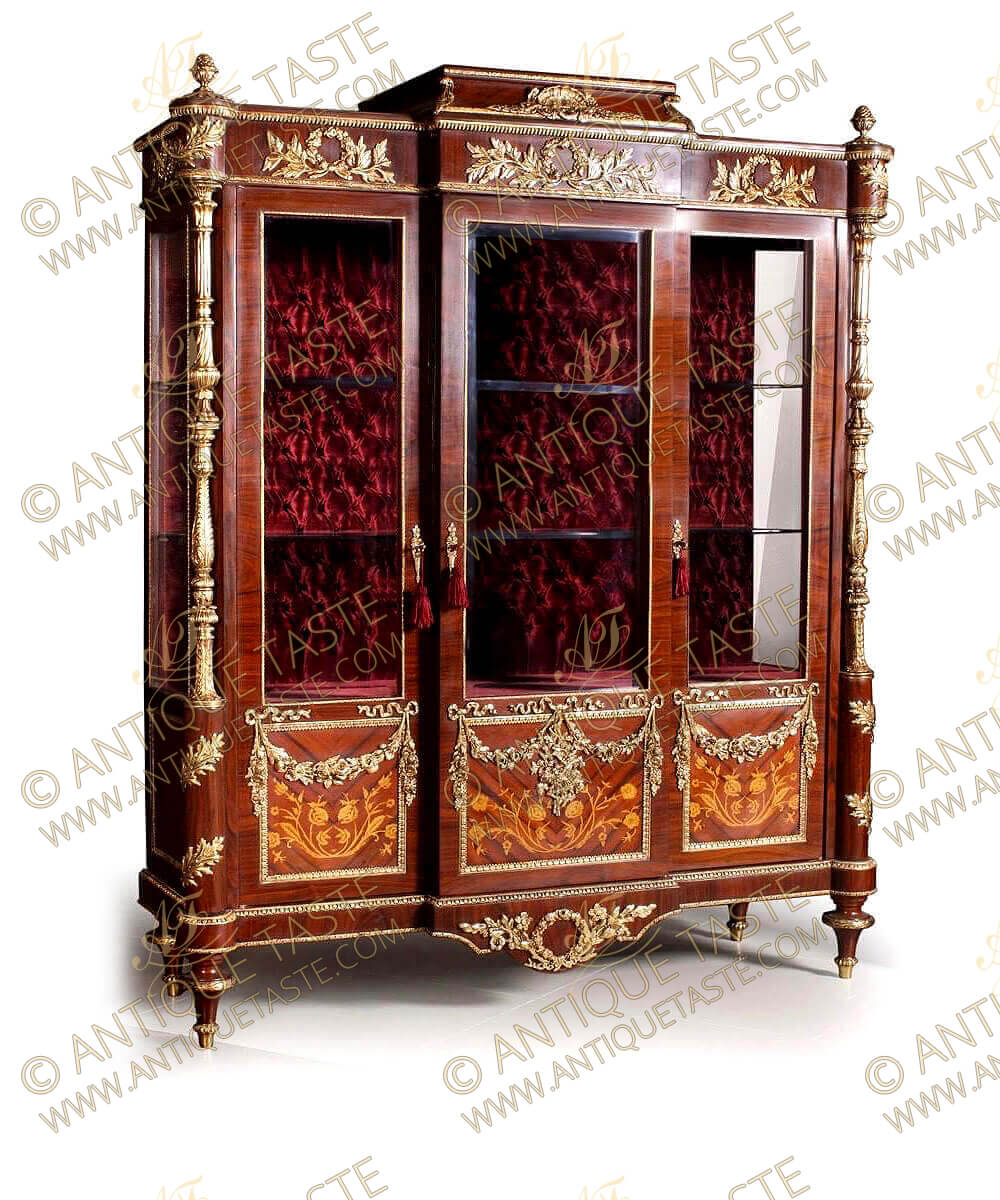Ref#V-1648 | Description
A royal French Louis XVI style ormolu-mounted veneer and marquetry inlaid China Cabinet after the model by Frédéric Durand et Fils, based on a model by Martin Carlin, Paris, Last Quarter 19th Century,
Crested with ormolu ornamented concave sides crown flanked with ormolu pine cones above an apron bordered with reeded pattern ormolu trim to the top and foliate ormolu trim to the bottom and adorned with three pierced interlaced swaged loose ribbon-tied laurel garlands above a breakfront body of three glazed ormolu filet bordered three-quarter doors with central protruding door, all have foliate ormolu keyhole escutcheon open to two glazed shelves with velvet fabric capitonné back.
The lower quarter sans traverse veneer inlaid and designed with naturalistic flowers marquetry patterns decorated with hung with ormolu blossoming pendant garlands. The sides are similarly decorated.
The corners with astonishing gilt-ormolu turned fluted colonnettes angle supports called "chinoises" surmounted with circular corner with an ormolu laurel leaf and same design continued underneath, all over an arbalette shaped apron adorned with Egg-and-dart pattern ormolu trim and centered with an ormolu ribboned-shape blossoming floral wreath and raised on ormolu mounted four toupie feet. The royal finish piece is a part of a dining set.
Ref#V-1648
180-50-200cm
Frédéric Louis Durand & Fils:
Gervais Durand was born in Paris on July 30, 1839. After 1870 he was a cabinet maker rue de la Cerisaie, number 12. He was so successful that in 1878 he had to move to another location, 23 rue Beautreillis. He won the silver medal at the world fair in 1889. Durand was both draughtsman and carpenter for his style furniture. He created beautiful copies of the great 18th century designers. In 1898 the company settled in the Hotel de Sully located 62 rue Saint-Antoine. In 1902, Gervais partnered with his son under the name “Durand et Fils” (Durand and Son). His son Frédéric Louis (1874-1933) took over the company when his father died in 1920. He himself partnered with his own son Pierre until the company closed out in 1933.
Martin Carlin:
Martin Carlin was born in Germany and emigrated to Paris to become an ébéniste. He settled there with other German and Flemish craftsmen and took employment in the workshop of Jean-François Oeben, whose sister he married. Inventories made after Carlin's death show that the ébéniste and his wife lived modestly in a five-room apartment in the Faubourg Saint-Antoine, an unfashionable quarter of Paris, with simple furniture, a few pastel portraits, and a black lacquer clock. Few of Carlin's wealthy clientele would have cared to venture into this area, and Carlin thus sold his works exclusively to middlemen such as the marchands-merciers Simon-Philippe Poirier and Dominique Daguerre.
Carlin was particularly known for his furniture decorated with Sèvres porcelain plaques, which he began to make in 1765, following designs supplied by the dealer Poirier. Although he made a certain number of larger pieces, secrétaires, tables, and commodes, Carlin's most popular works were small, portable, and extremely elegant items such as small tables, music stands, and jewel cabinets. A master of the Neoclassical style, he also produced works set with lacquer panels and veneers of mahogany.
Tags
- #Frédéric_Durand_et_Fils_Vitrine | #Martin_Carlin_style_China_Cabinet | #Louis_XVI_Martin_Carlin_Display_Cabinet | #Louis_XVI_ormolu_mounted_vitrine | #Francois_Linke_vitrine | #Vernis_Martin_Style_Vitrine | #Grande_Vitrine_LouisXV | #Napoleon_Style_China_Cabinet | #French_Napoleon_display_cabinet | #Francois_Linke_display_cabinet | #Luxurious_vitrine | #corner_furniture | #Serre_Bijoux | #jean_henri_riesner_vitrine | #Leon_Message_vitrine | #cabinet_vitrine | #Louis_xv_vitrine | #Louis_xvi_vitrine | #ormolu_mounted_vitrine | #Louis_XIV_vitrine | #display_cabinet | #vernis_martin_style_vitrine | #French_style_vitrine | #glass_vitrine | #English_style_vitrine | #veneer_inlaid_vitrine | #marquetry_vitrine | #Italian_style_vitrine | #glass_round_vitrine | #boulle_style_vitrine | #antique_reproduction_vitrine | #antique_style_display_cabinet | #empire_style_bookcase_vitrine | #display_cabinet_with_porcelain_plaque

